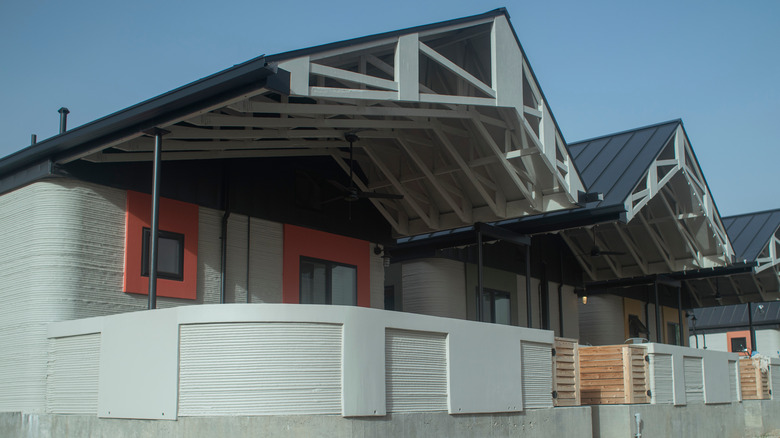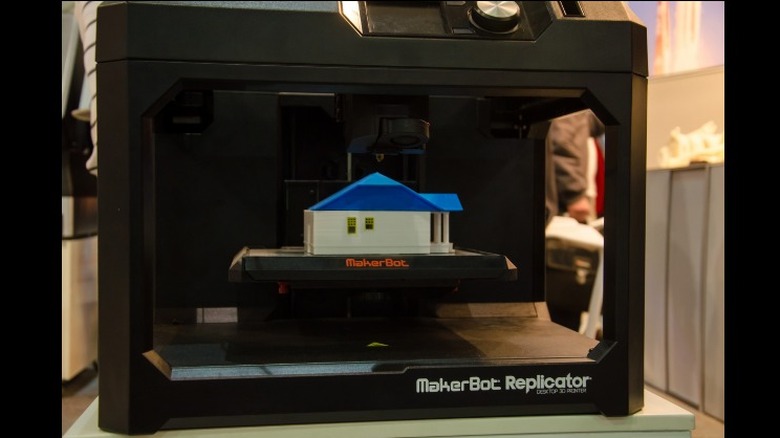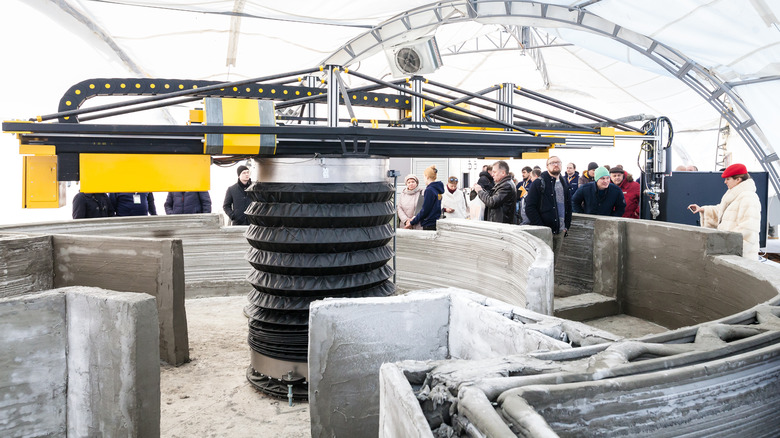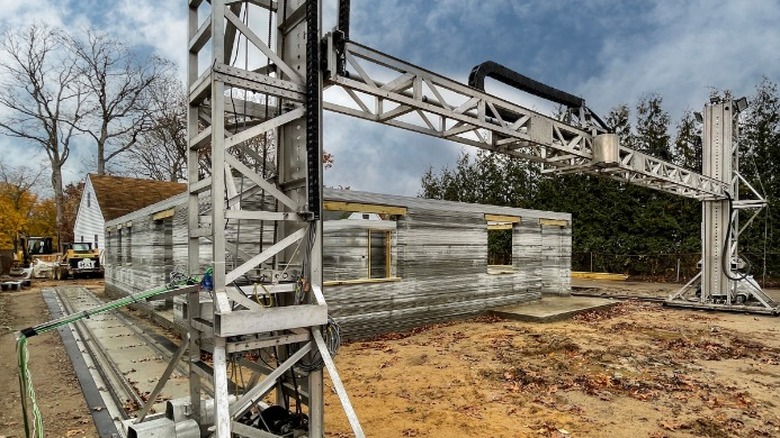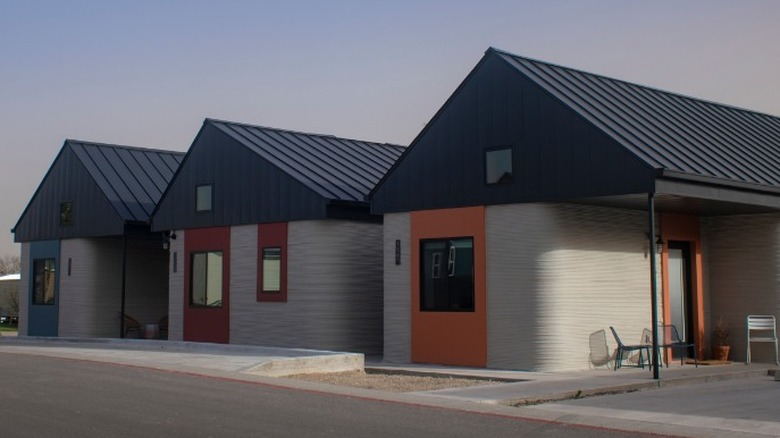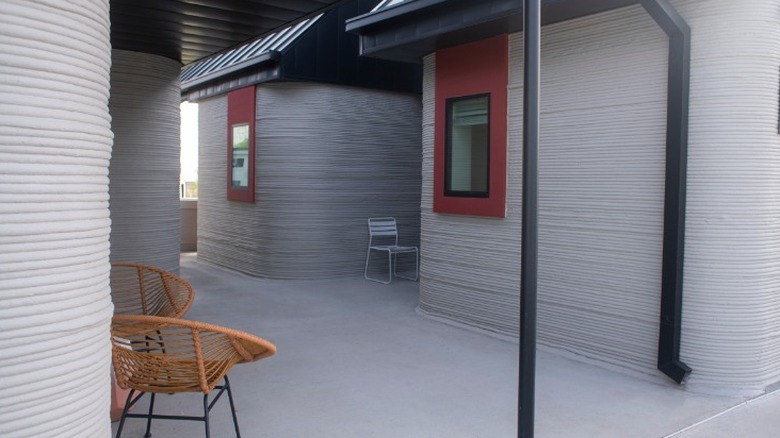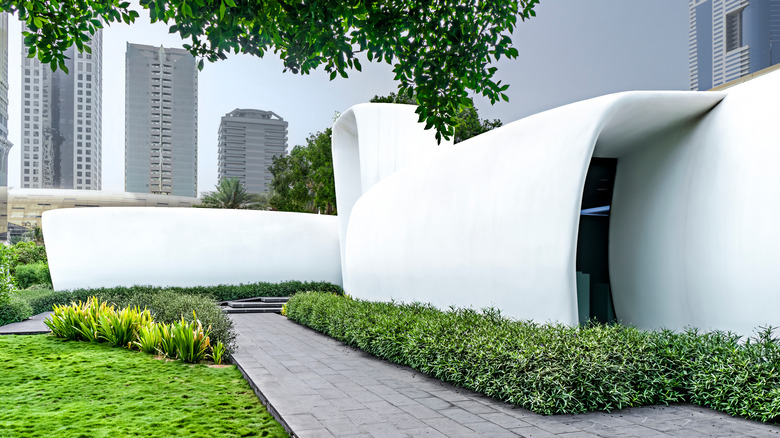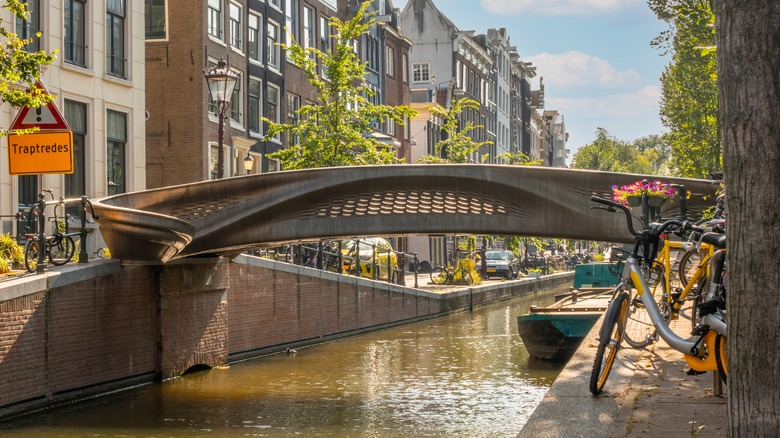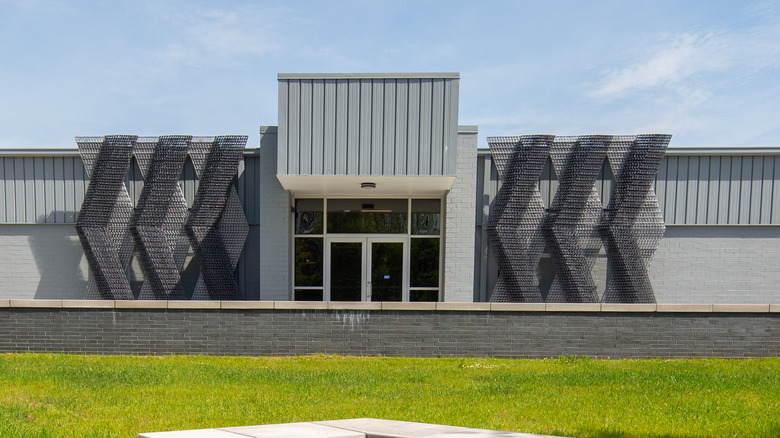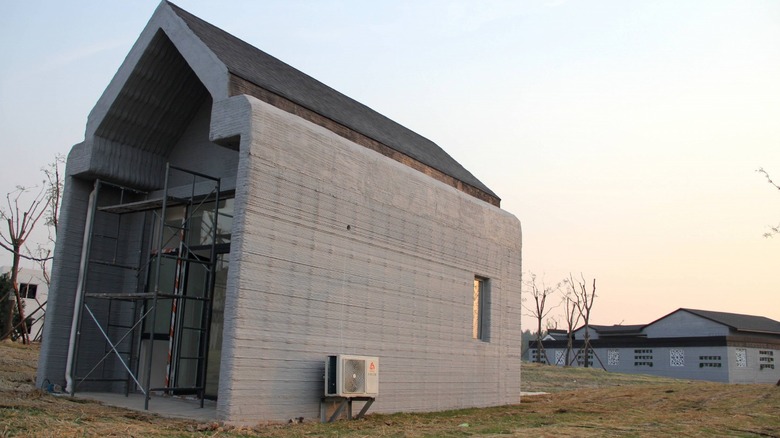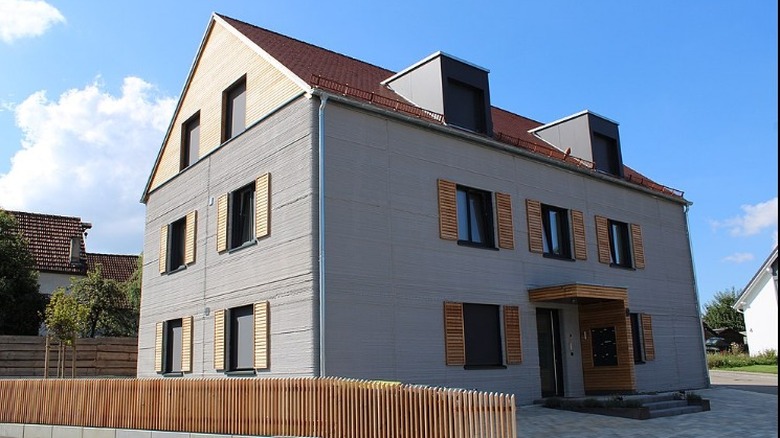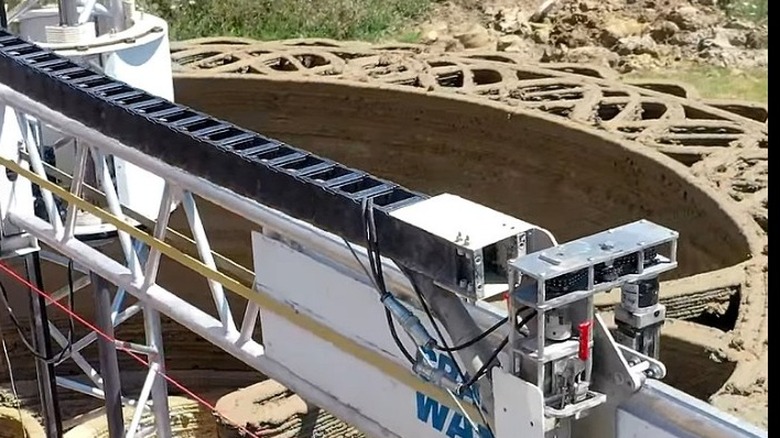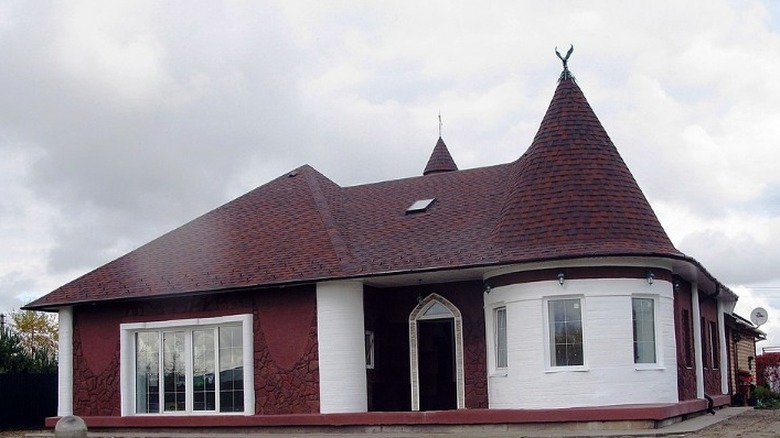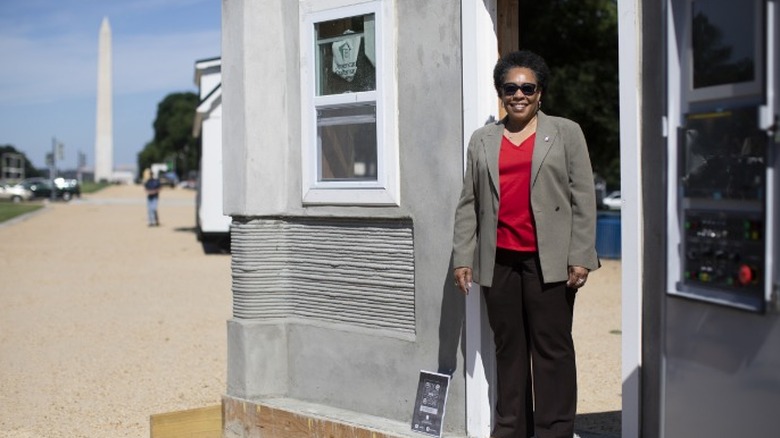Could Your Next Home Be 3D Printed? Everything To Know About The Future Of Construction
3D-printed houses seem poised to be the next revolution in home construction. Utilizing 3D-printing technology on a grand scale like that needed to craft houses unleashes design potential and removes many barriers to traditional construction materials and methods presented. The basics of 3D printing are exactly the same as the machine that sits on a desk creating chess pieces, only it is fed cement and is literally the size of a house. Some clever designs have come out recently and several companies are working to spread house printing worldwide.
Consider what goes into building a house. A contractor's team of workers must measure, cut, and assemble lumber beams one by one until a house is framed, only to be followed by insulation and drywall. The next step is trimming, weatherproofing, and so on until the house is complete. This requires a lot of time, materials, and workers. With 3D printing, a large machine lays a narrow line of concrete over a pre-determined path and repeats itself in rows, building height each time. It is amazingly simple and stronger than wood. Once the printer is done, the only thing left to do is add a roof, windows, and doors. This technology is just now catching on and is not widely known, so here are a few of the untold truths behind this method of home construction.
The tech is older than you might think
While compact 3D printers have proliferated in the last few years with seemingly everyone able to create whatever they want at home, the technology has been around for a while. Some of the first patents for what would become 3D printers were filed in the '70s. Stereolithography, the method that makes 3D printing possible, was patented in 1984, and the first device to use it was created in 1987. It was in the '90s that advances in medical and industrial applications saw significant gains that would ultimately lead to widespread adoption. In 2006, the Makerbot arrived and set off a technology revolution in DIY 3D printing and the proliferation of the technology to everyone (via Redshift).
Since then, individuals and companies have been pushing the technology in new directions, figuring out ways to use new materials to create an ever-growing list of objects not possible without mass production just a decade before. This includes scaling up the printer to the size of a house. According to House Beautiful, Habitat for Humanity announced in January 2022 that the first owner-occupied house built with 3D printing will be available to a family in Virginia. Habitat, a charity that builds homes for low-income families, is energetic about the possibility of continuing to use 3D printing to help more families around the nation. Things are just beginning for the 3D printed home.
Printed homes are built fast
Realtor.com states that the average time to build a home in the U.S. is about seven months, from permit approval to final inspection. Furthermore, location can play a difference with homes in the Northeast taking up to three months longer. One of the major promises of 3D printing is the reduced time of construction. Big Think reported that the Habitat house printed portion was completed in just 28 hours. It cuts down the time needed to frame, hang drywall, and trim the house to just over one day. With the finishing touches of installing windows, doors, and other tasks, construction time should be cut from seven months to less than one.
A New York company called S-Squared 3D Printers claims that it is capable of building a modest-sized 1,900 sq. ft. home in just eight days from start to finish. Of that time, only 48 hours were used for the printing portion of the build. With huge deficits of affordable homes in this country, 3D printing could help alleviate housing problems and ease pressure on rising rents at the same time.
Low-cost construction
Building houses with a printer reduces not only the raw materials needed to create the structure but also the workers needed. The most strenuous part of the project is setting up the printer, which is a large and complex assembly. When it is set up and in place, the machine does most of the work with only a couple of workers to monitor the progress. Austin-based Icon is going all-in on 3D printed houses, having already built a 350 sq. ft. prototype house in Austin with its patented printing system. According to Insider, Icon says that their Austin house, which was built in 48 hours, cost about $10,000, but that they expect to be able to get it down to $4,000 going forward while increasing the size and reducing the building time.
On a larger scale, SQ4D of Long Island recently listed its first printed home for sale, per the Today Show. Situated on a quarter-acre lot on Long Island, the house is 1,400 sq. ft. with three bedrooms and a two-car garage. The listing was priced at just under $300,000, which is about half the usual price for the area. On its official website, SQ4D boasts of having completed the largest printed house to be listed for sale. This one is listed as a 2,000 sq. ft., four-bedroom, and two-bathroom home and only required 15 days to print. It appears that 3D-printed houses are poised to disrupt the market.
Housing in the developing world
While the housing needs in the U.S. are acute and genuine, needs in other parts of the world are often dire. The lack of decent and affordable housing often leads to vast slums with unsanitary living conditions. Non-profit charity New Story has been working to provide housing to people in Central America, having built 150 homes in El Salvador over the past few years, according to Wired. Having raised the money to build 1,300 homes over the last few years and completing 850 already, COO Alexandria Lafci wanted to see if there was a better way to make this happen faster and help more people. Then she found Icon.
New Story is now working with Icon to bring its technology to the developing world. The 350 sq. ft. house already built is a prototype house for what want to start building in Latin America. Current houses take eight months and cost about $6,000, and Icon wants to get that cost down to $4,000 with a construction time of less than a week. Perhaps the biggest challenge is the logistics of moving this enormous equipment to places with poor infrastructure and extreme climates. With some success now, this could become life-changing to vulnerable communities all over the globe.
Printed homes can be sustainable
Home construction has a dramatic impact on the environment. From the clearing of forests for lumber to the carbon emissions from diesel and gas-powered equipment, construction has an ecological cost. 3D-printed homes help to reduce this by building from mostly sustainable concrete and consuming less fuel in the process, creating fewer emissions. 3D printing also produces a lot less waste, as building construction produces millions of tons of waste sent to landfills each year. While these benefits are real and tangible, they can get better by using all-natural or recycled materials.
Azure is a company looking for alternative ways to print new homes. Its process uses recycled plastic for its printer, and the source material is largely water bottles and food packaging. Rather than printing a home onsite, Azure is creating pre-fabricated pieces in its warehouse and shipping them for assembly on-site. Current offerings are for small structures meant as extra spaces to be placed in a backyard, but plans for complete dwellings are in the works (via Bob Vila).
Taking sustainability a step further, an Italian architect has created plans for printing structures using clay from natural materials nearby. A firm has already been contracted to implement the design and build test structures to prove the concept works (via My Modern Met). 3D printing alternatives are just now being explored and more innovative building materials are surely still to come.
Printed homes can resist natural disasters
The printed homes using concrete are not just fast and affordable to build, but they are also strong. Concrete is one of the strongest and most resilient building materials we have at our disposal today. It is also durable and long-lasting and structures made from concrete will last for decades with little to no maintenance. This is also what makes homes printed of concrete perfect for areas known for extreme weather.
Houston Chronicle reported about the development of printed homes in the area as Houstonians are all too aware of the impacts of hurricanes, having suffered through the devastation of Harvey in 2017. Icon is also working in its home state to build a set of five homes near the Gulf Coast designed to withstand a Category 5 hurricane. Icon's CEO takes this project personally as he had once spent a Christmas in a FEMA trailer and lost his family home, the Chronicle notes. Concrete structures can withstand the forces of hurricane winds, but they also prevent mold growth and flooding, making them ideal for use on the Gulf Coast and other areas prone to extreme weather events.
Design is not limited
Traditionally built homes often have a traditional look for good reasons. The materials available and the contractors experienced enough to build homes both work within well-established home designs. Creating avant-garde architecture is possible, but pricey. Using squares and rectangles and plenty of right angles makes homes easier and faster to construct and when curves and slants or other shapes enter the plans, costs rise dramatically. However, with a 3D printer, those constraints evaporate.
With a 3D printer, houses can be built in almost any shape or form you can imagine. Curves and odd angles for walls are no problem and take no more time than a big square. This leaves much room for the imagination of designers. Yanko Design writes about the broad array of designs created already, noting the unique attributes. It features a steel-printed bridge in Amsterdam featuring flowing shapes and repeating lattice on the sides; a cantilevered home of large box-like structures stacked to form a house in San Sebastian, Spain; and another Amsterdam project to build traditional-style canal houses from recycled plastic that has already begun construction. Arch Daily examines the unconstrained digital nature of the printing process that allows for dynamic design creations that can be plotted on computers long before any construction begins. The evidence of initial projects being completed around the globe is evidence that this construction method is viable and growing.
The Future of home construction
The promises of 3D printing are enticing. The ability to quickly and affordably build homes on a grand scale appears to be the future of home construction. But what does the future hold for the millions of contractors working in this industry across the country and across the world? The possibilities for cost and time savings are incredible, and the ability to explore creative designs is equally intriguing. So what sort of roadblocks or difficulties lie ahead for the printed home construction industry?
An opinion piece from Architizer posits some detrimental qualities of the printed structure. To highlight a few, officials in Dubai want to create a hub of 3D printing in their city and for it to be a center of innovation in the industry. They have some clever offices printed already, but, in a city of gleaming skyscrapers, printed structures are presently limited to just a couple of stories and huge hurdles must be overcome to build anything like a skyscraper. The tendency for printed walls to take on a cave-like aesthetic could also be a turn-off for buyers who are accustomed to typical plaster or sheetrock-finished walls.
Despite some objections to the adoption of 3D printing in home construction, opportunities abound. The only thing that would truly hold it back is a lack of creativity in problem-solving and irrational fear of change. If people will embrace the future and see the benefits of new approaches, 3D printers could be as common on home sites as carpenters.
Downsides of 3D construction
While the world of printing homes sounds very promising and many real-world benefits may be realized from this process, it is not perfect and a few roadblocks may arise. As with any new technology, there is a learning curve and the only way for the industry to sort things out is to risk the financial and time investment and dig into some projects.
For construction to begin, expensive machinery needs to be built or purchased. This significant investment, according to Utopia, can run close to a million dollars and investors can be gun-shy around unproven building processes. Adding to the investment risk can be the inconsistency of materials. Since many companies are testing and developing different methods, no single standard yet exists, and some trial and error is inherent to establishing 3D-printed homes as a mainstream concept. Lastly, pricing can be difficult largely due to the relatively small cost savings 3D homes currently offer. However, with more time and experience with this method, costs will be reduced, especially as the process scales up around the world.
With time, any or all of these issues can be overcome. We are just now seeing the first completed commercial housing projects using 3D printers and it is still relatively unknown in the public's mind. More work by intrepid startups along with media publicity outside of niche tech blogs and industry publications will help the benefits be realized by a wider group of homebuyers.
Insulation concerns with 3D printing
Printing a house may be a novel approach to home building, but keeping the occupants comfortable will be as much of an issue as with current construction methods. Printed homes do offer some inherent benefits against the weather. Using concrete as a medium builds nearly impermeable walls and many designs leave voids within the walls, creating air gaps that help to insulate the building. Arizona Public Media reported that Habitat For Humanity has used concrete to build the walls and then packs the voids with insulation, creating a home with excellent insulating qualities that will help keep energy use low.
In Amsterdam, the 3D Print Canal House is being used as a showcase for the technology not just to gather interest in it, but also to serve as a test bed for expanding and improving printed building processes. Mediamatic writes about architects working within the space who have used a portion of the building to stuff with a substrate, which is just bits of straw, and adding to it the mycelium of oyster mushrooms. As the mycelium grows, it will hold the straw together like glue, serving as a wholly sustainable insulation solution.
Clever architects and engineers are already coming up with novel ways to ensure comfort in these homes and, as the projects grow, more ideas will come down the pike.
[Featured image by Looniverse via Wikimedia Commons | Cropped and scaled | CC BY-SA 4.0]
3D printing offers diverse material choices
So far, the majority of projects that have received media publicity have been made of concrete or a proprietary material similar to concrete. However, recyclable plastics are also being studied and used and other materials are also in the works, including highly sustainable organic and biological ingredients.
The University of Maine has been at the forefront of printed housing research and operates a facility to explore this new technology. In November of 2022, WBUR reported that the university held a ribbon-cutting unveiling of its first completed home made of biodegradable material from industrial waste. Using the residual material leftover from sawmill operations where timber is processed into ready-to-use lumber combined with a binder made from corn, the University was able to 3D print a 600-square-foot house. The completed project resulted in a durable structure that used a printing process that allowed the printer to build the structure from floor to ceiling and traditional materials only needed to be used for the windows, doors, and other openings. Thanks to funding from the U.S. Department of Energy and the Oak Ridge National Laboratory, progress is being made toward lowering the nationwide housing shortage with this technology.
[Featured image by Alfredo Milano via Wikimedia Commons | Cropped and scaled | CC BY-SA 2.5]
3D-printed projects area now ready to go
With all of these entrepreneurs, engineers, architects, and inventors working at a quick pace to develop this new construction method, several projects are well underway and nearing completion.
The aforementioned project by Austin-based ICON is way beyond initial stages with its Wolf Ranch community. Pictures included in a report by Business Insider show the neighborhood filled with what appears to be completed homes and says that sales will begin in 2023, with new homes to be priced around $450,000. Another development from ICON as reported by New Atlas shows several completed homes and a website for the East 17th Street Residences lists some units already sold. However, the Austin American-Statesman reported on November 25, 2022, that a fire engulfed the main facilities of ICON with no word on how that has affected construction.
Projects are also happening outside of Texas. ALL3DP lists some notable projects at or near completion also. Habitat for Humanity has already built its first house and transferred it to its new resident while a Wallenhausen, Germany apartment building had its first residents move in back in August of 2021. Other test projects are moving into full production in India, Africa, China, Mexico, and elsewhere, indicating the printed house boom is gathering steam and will likely find its way to your community soon.
[Featured image by AMT-SPETSAVIA Group via Wikimedia Commons | Cropped and scaled | CC BY-SA 2.5]
3D innovations in the pipeline
As 3D-printed construction expands into new markets, more innovation is sure to find its way into 3D printing. Collaborations between engineers and architects and young upstart entrepreneurs are sure to bring fresh ideas to the table and further enhance the methods and materials used.
So far, the bulk of the work and innovation of this technology has concentrated on one or two-story single-family homes and small-scale multi-family dwellings. Some projects have also been instituted for public spaces mostly as functional art projects or expositions of the technology. However, some ideas are bubbling to the surface to expand printing to larger construction projects such as skyscrapers.
Cazza Technologies of Dubai announced in 2017, according to Futurism, that it will be building a 3D-printed skyscraper in the arid country, although no news appears to have surfaced since the announcement. Another project idea from a Malaysian architecture student is to build a skyscraper in which apartments can be individually printed as pods within a steel framework. Finally, MIT Technology Review reported that scientists have demonstrated 3D printing drones that could be dispatched as swarms using a unique lightweight cement. Tests have been successful on structures up to 2 meters, so much development will be needed for full-scale construction to begin. The 3D-printed building field is wide open and we are sure to see many clever ideas come to fruition in the near future.
